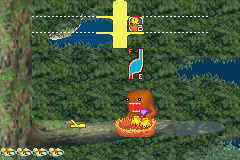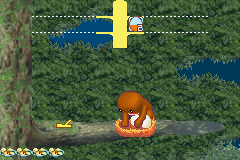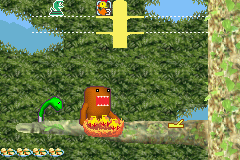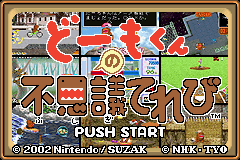Retro Replay Review
Gameplay
Domokun no Fushigi Terebi offers a delightful collection of bite-sized mini-games that are easy to pick up yet surprisingly challenging to master. Each stage represents a different television program—from nature documentaries where you help hatch delicate bird eggs to fast-paced baseball broadcasts demanding precise timing for home runs. The variety ensures that players rarely feel stuck in a single gameplay loop, as each segment rewards quick reflexes and pattern recognition.
Controls are crisp and responsive, taking advantage of the Game Boy Advance’s modest button set without overwhelming the player. Whether tapping A to crack an egg shell or pressing B at just the right moment for a homerun, the mechanics feel intuitive. A running difficulty curve keeps the challenge engaging: early stages introduce concepts gradually, while later levels require split-second decisions and perfect timing.
Replayability is high thanks to score tallies and medal systems. After finishing a mini-game, players are encouraged to revisit stages to improve their ranking or beat target scores. This adds an addictive quality, particularly for completionists aiming to unlock all hidden modes. Though each mini-game lasts only seconds, the cumulative experience packs a satisfying depth that belies the handheld’s limited hardware.
Graphics
Graphically, Domokun no Fushigi Terebi makes the most of the Game Boy Advance’s color palette, delivering vibrant and expressive sprites. Domo-kun himself is rendered with clear, bold outlines and a charming animation loop that brings his frustration and determination to life. Backgrounds are detailed enough to evoke distinct TV show atmospheres—lush green fields for nature segments, a cheering crowd for baseball, and flashy neon lights for rhythm games.
The transition screens between programs showcase playful animated effects, replicating the feel of channel-surfing on an old TV set. While the GBA’s resolution limits the number of on-screen elements, the designers cleverly use contrasting colors and simple shapes to communicate critical information at a glance. Health bars, timers, and score counters remain legible even during frantic action sequences.
Special effects—such as screen shakes when Domo-kun slams the TV or colorful bursts during rhythm games—add a layer of polish that keeps the visuals from feeling static. Though the title doesn’t push the console’s graphical envelope, its consistent art style and lively character animations make each mini-game visually appealing. Fans of 2D handheld graphics will appreciate the attention to detail and the cohesive design language throughout the experience.
Story
At its core, Domokun no Fushigi Terebi presents a simple yet endearing narrative: Domo-kun’s frustration over a broken television leads him into an otherworldly broadcast realm. This premise serves as an effective framing device for the game’s diverse content, allowing for creative freedom in designing each mini-game around different TV genres. The story itself is light on dialogue but rich in whimsy, capturing Domo-kun’s signature charm.
Characters and settings are introduced through brief cutscenes that establish context without slowing the action. Usaji, Domo-kun’s caretaker, offers only a few lines of exasperation before Domo-kun’s misadventure begins, letting the gameplay take center stage. The minimal narrative holds enough cohesion to make you care about reaching the “real world” again, but never overstays its welcome with excessive exposition.
Despite its brevity, the story’s structure cleverly mirrors the pacing of classic television programming. Each mini-game feels like flipping to a new channel, and the desire to see “what’s next” drives progression. For players who appreciate a light narrative thread tying disparate challenges together, Domokun no Fushigi Terebi strikes a satisfying balance between plot and play.
Overall Experience
Domokun no Fushigi Terebi stands out as a wonderfully curated mini-game collection that holds up well among other Game Boy Advance titles. Its quick-hit design makes it perfect for short commute sessions or brief breaks, while its underlying depth and score-chasing mechanics encourage extended play. The overall package feels polished, from the responsive controls to the coherent art direction.
The game’s replay value shines through its unlockables and performance medals. Whether you’re aiming for gold-timing each rhythm section or perfecting every baseball swing, there’s always another target to pursue. Multiplayer isn’t included, but the solo challenge is robust enough to keep completionists and high-score hunters engaged for hours.
For fans of Domo-kun or casual gamers looking for a lighthearted, accessible arcade experience, Domokun no Fushigi Terebi is a must-have on the GBA. Its blend of charming visuals, varied gameplay, and gentle narrative framing make it a standout title in the handheld’s library. Even years after its release, the game retains a fresh, inviting personality that makes channel-surfing through mini-games as fun today as it was at launch.
 Retro Replay Retro Replay gaming reviews, news, emulation, geek stuff and more!
Retro Replay Retro Replay gaming reviews, news, emulation, geek stuff and more!









Reviews
There are no reviews yet.